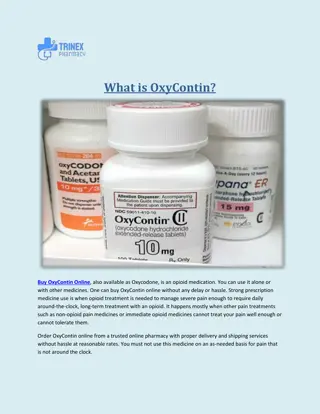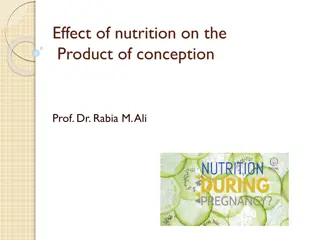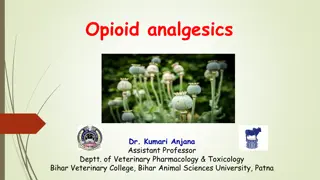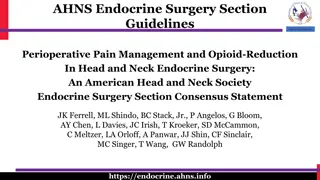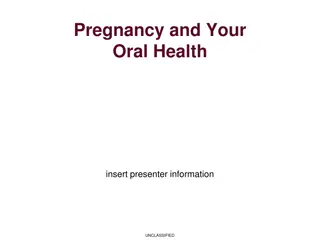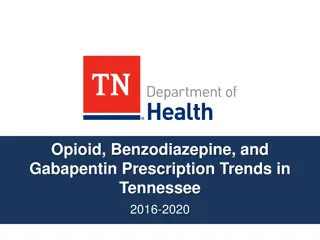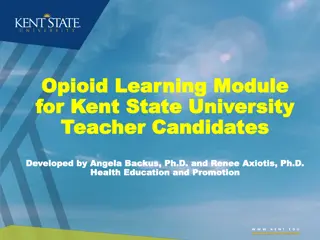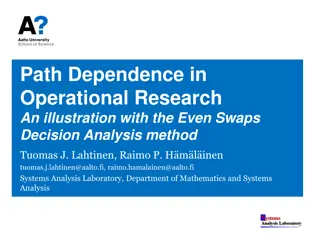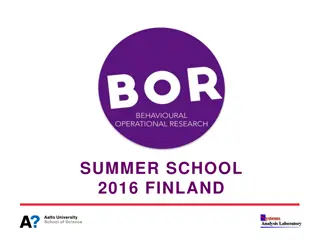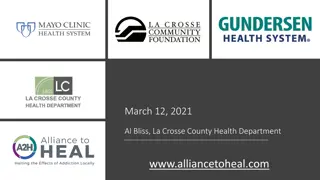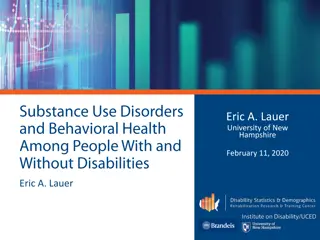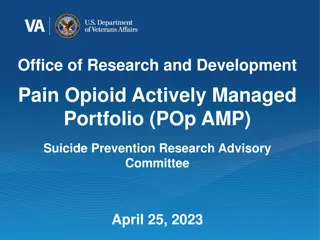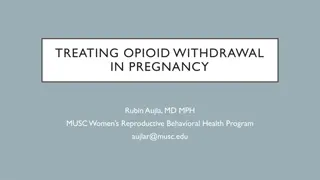Management of Opioid Dependence During Pregnancy: Best Practices for Mother and Baby
The presentation addresses best practices for managing opioid dependence during pregnancy, focusing on treatment options, inpatient care, and guidelines for Neonatal Abstinence Syndrome (NAS). It discusses concerns, laws in the USA regarding substance abuse during pregnancy, and reporting practices in Canada.
Download Presentation

Please find below an Image/Link to download the presentation.
The content on the website is provided AS IS for your information and personal use only. It may not be sold, licensed, or shared on other websites without obtaining consent from the author.If you encounter any issues during the download, it is possible that the publisher has removed the file from their server.
You are allowed to download the files provided on this website for personal or commercial use, subject to the condition that they are used lawfully. All files are the property of their respective owners.
The content on the website is provided AS IS for your information and personal use only. It may not be sold, licensed, or shared on other websites without obtaining consent from the author.
E N D
Presentation Transcript
Department of Family Medicine Management of Opioid Dependence During Pregnancy: best practices for mother and baby Laura Lyons, MD, CCFP (AM) Associate Professor, Medical Director of Family Medicine Obstetrics March 21, 2019
Disclosure of Commercial Support This program has received no commercial financial support. This program has received no in-kind support.
Mitigating Potential Bias Not applicable.
Management of Opioid Dependence During Pregnancy Objectives: 1. Management options for OAT during pregnancy. 2. Inpatient / intrapartum management of OUD patients 3. NASguidelines and hospital policies
The Concern One third of patients on OAT treatment are women of childbearing age. The rate of opioid use is 5.6% per 1,000 live births 85% of pregnancies in women with a opioid use disorder were unintended There is an increased fertility with treatment due to psychosocial and physical stabilization
The USA In 2014, Tennessee became the first state to pass a law criminalizing illicit drug use during pregnancy. 18 states consider substance abuse during pregnancy to be child abuse under civil child- welfare status. Largest barrier to women accessing prenatal care is fear of child welfare consequences.
The USA US Congress has passed the Protecting Our Infants Act of 2015. This act specifically calls for a critical review of current treatment options for prenatal opioid abuse which may ultimately lead to the development of better therapies and a decreased incidence of neonatal abstinence syndrome.
In Canada Duty to report to the Children s Aid Society Under section 72 of the Child and Family Services Act every person who has reasonable grounds to suspect that a child is or may be in need of protection must promptly report the suspicion and the information upon which it is based to a Children's Aid Society. Variance among regions in reporting practices and intervention practices by CAS Reporting not required until birth. Self referral to CAS encouraged to pregnant patients actively using substances.
Health Canada, 2011 Methadone maintenance treatment is considered the standard of care for women who are pregnant and dependent on opioids.
SOGC (Society of Obstetrics and Gynecology of Canada, Substance use in pregnancy, clinical practice guidelines, 2011) Methadone maintenance treatment should be standard of care for opioid-dependent women during pregnancy. (II-IA) Other slow-release opioid preparations may be considered if methadone is not available. (II-2B) Opioid detoxification should be reserved for selected women because of the high risk of relapse to opioids. (II-2B) Opiate-dependent women should be informed that neonates exposed to heroin, prescription opioids, methadone, or buprenorphine during pregnancy are monitored closely for symptoms and signs of neonatal withdrawal (neonatal abstinence syndrome). (II-2B) Hospitals providing obstetric care should develop a protocol for assessment and management of neonates exposed to opiates during pregnancy. (III-B)
Methadone Maintenance Treatment
Pregnant Women and MMT The potential benefits include: safer, medically supervised opioid use (stable supply, pure quality, no fluctuating blood level, no exposure to contaminants) decreased risk of transmission of HIV (and potentially HCV and other blood-borne pathogens) (including decreased risk of transmission of HIV to infants) increased likelihood that infant will be discharged into his or her parents' care; and increased retention in treatment (Kandall et al, (1999), The methadone maintained pregnancy. Clin Perinatol, 26: 173-83)
Post Emesis Dosing If emesis occurs less than 15 minutes after consumption, consider replacing 50-75% of full dose If emesis occurs at between 15 and 30 minutes after consumption, consider replacing 25-50% of full dose If emesis occurs at more than 30 minutes after consumption, do not replace dose
Dose Adjustment During Pregnancy Up or Down? During pregnancy, methadone dose increases may be required due to increased metabolism and blood volume. This is often not required until the late second or third trimester. An alternative to increasing methadone dose is providing BID dosing. Methadone dose should be titrated according to the woman s symptoms, in order not to escalate the dose beyond her clinical requirements. Methadone dose should not be kept low in an attempt to reduce neonatal abstinence syndrome. Health Canada, 2011
Research MMT versus Illicit Drug Use Higher methadone doses in the third trimester are associated with less illicit drug use Higher third trimester doses are also associated with an increased fetal head circumference. Increased head circumference may reflect both increased gestational duration and improved overall growth (Hagopian et al, Journal of Maternal Fetal Medicine, 1999)
METHADONE TAPERING DURING PREGNANCY
CPSO Methadone Maintenance Treatment Standards and Guidelines 2011 Methadone Assisted Withdrawal Has not demonstrated any increased incidence of obstetrical complications or adverse neonatal outcomes during first, second or third trimester (Maas et al., 1990, J Perinatal Med, 18, 111-118, Jones et al, 2008, American Journal of Addictions, 17, 372-286.). Associated with clinical instability and a high risk of relapse to substance use
MMT Tapering During Pregnancy SOGC, 2015 Motivated women who have a short addiction history, are medically and socially stable with a good support network and have no concurrent psychiatric disorder may have better outcomes following a methadone withdrawal program.
MMT Tapering During Pregnancy There is limited guidance in terms of the rate of methadone tapering or detoxification. Studies have proposed reducing the dose by 1-2 mg/day as an inpatient or by 2-10 mg every 1-2 weeks as an outpatient In percentage of dose, maternal dose should be decreased slowly by 5- 10% per week. This process should be stopped if the pregnant woman reports any adverse outcomes such as relapse to drug use, increased cravings, intolerable withdrawal symptoms or obstetrical complications. (Archie 1998; Finnegan 1991; Jarvis and Schnoll 1994; Kandall et al. 1999)
BUPRENORPHINE MAINTENANCE TREATMENT
BUPRENORPHINE MAINTENANCE TREATMENT Buprenorphine is an opioid agonist-antagonist. It is a sublingual tablet, approved for use in Canada in 2007 and is first line in OUD maintenance treatment Partial mu-opioid agonist produces opioid-like effects equivalent to methadone Induction process places patient at risk for precipitated withdrawal. Effective dose range: 8-24 mg/day
BUPRENORPHINE USE DURING PREGNANCY Pregnant women may be treated with buprenorphine mono-product (Subutex) available through Health Canada exceptional access program Available as buprenorphine-naloxone combination (4:1 ratio) to deter intravenous misuse = Suboxone Naloxone: lack of safety data during pregnancy. Transfer from MMT to buprenorphine not advised during pregnancy. Safety of buprenorphine during lactation unclear but it s use is not contraindicated when breastfeeding.
Mother Study Jones et al., NEJM, 2010; 363(24); 2320-2331 Double-blind, double-dummy RCT [MOTHER study] Buprenorphine compared to methadone use in 175 pregnant women with opioid dependence Percentage of neonates requiring treatment for withdrawal did not differ Buprenorphine results in reduced severity NAS
Mother Study (continued) Neonates exposed to buprenorphine required: 89% less morphine spent 43% less time in hospital 58% less time in hospital receiving medication for NAS
Management of Opioid Dependence During Pregnancy Detoxification from opioid drugs during pregnancy
Management of Opioid Dependence During Pregnancy Research on Detoxification Two main concerns: 1. safety issue for the fetus 2. high rate of relapse following detoxification, including overdose.
Management of Opioid Dependence During Pregnancy 2 case reports (1970s) and 5 retrospective studies (1990-2013) Luty et al (2013) 101 women underwent a 21 day inpatient methadone detoxification program. Conclusion: opioid withdrawal may be associated with an increased risk of miscarriage in first trimester but likely safer in second and third.
Management of Opioid Dependence During Pregnancy Detoxification from opiate drugs during pregnancy Bell,H, Towers,CV, Hennessy,MD, Heitzman,C, Smith,B, Chattin,K American Journal of Obstetrics and Gynecology, 2016;215:374e1-6
Management of Opioid Dependence During Pregnancy Retrospective analysis of data collected prospectively during ongoing prenatal care of opiate addicted pregnant women University of Tennessee Medical Centre, Knoxville, TN Data analysis of complications of intrauterine fetal demise, fetal distress and preterm labour leading to delivery in pregnancies that underwent detoxification.
Management of Opioid Dependence During Pregnancy Four different arms: 1. Incarcerated patients undergoing acute withdrawal 2. Inpatient drug detoxification using buprenorphine fully detoxifying patients in 5-8 days. Followed by intense behavioural program 3. Inpatient detoxification without behavioural program 4. Outpatient slow buprenorphine detoxification program
Management of Opioid Dependence During Pregnancy Rate of Relapse Group 1 Group 2 Group 3 Group 4
Management of Opioid Dependence During Pregnancy Rate of NAS Group 1 Group 2 Group 3 Group 4
Conclusions (Bell et al, 2016) In conclusion, detoxification of opiate addicted women does not appear to be harmful. In addition, the rate of neonatal abstinence syndrome can also be reduced if continued long term behavioural follow up occurs once the patient is drug free. BUT Results: 2 miscarriages and 1 premature birth, no fetal assessments during rapid detoxification process.
What about the assessment of fetal distress? Zuspan and colleagues case study Tapered off methadone while monitoring serial amine (epinephrine and norepinephrine) levels in amniotic fluid. Amine levels increased as methadone dose was decreased. Amine levels return to baseline and stabilized after methadone tapering was discontinued.
Opioid dependence and pregnancy: minimizing the stress on the fetal brain McCarthy et al, 2016 AJOG Crude fetal mortality rates are not adequate outcome measures. Acute maternal withdrawal results a catecholamine surge, uterine contractions and reduced placenta blood flow and oxygen supply. Corticosteroid excess associated with withdrawal can signal rapid modification of neurotransmitter systems and transcriptional machinery. This may trigger permanent modifications of behaviour and brain morphology.
Summary of the research Maternal opioid withdrawal does decrease incidence and duration of NAS however it is uncertain the effects on fetal brain development Maternal relapse ranges from 59-99% Conclusion: detox is inferior to OAT due to risk of maternal relapse, with inherent overdose mortality risk this outweighs the potential reduction in NAS The effects of detoxification on fetal well-being is a key area of future research.
Management of Opioid Dependence During Pregnancy Naltrexone in the treatment of opioid dependent pregnant women future considerations
Long acting naltrexone any future role in treatment? Pregnancy category C drug non selective-opioid receptor antagonist. Effective for treatment by decreasing drug seeking behaviours, drug craving and increasing treatment retention. Australian case reports have shown no teratogenic effects (Hulse et al, 2002) In comparison to MMT implanted naltrexone shows lower: lower rate of preterm labour, higher birth weights and higher APGAR score no significant difference in gestational age at birth, or birth weight Does not demonstrate tolerance leading to increased dosing during pregnancy (Hulse et al, 2004)
Unresolved issues: a research review (Jones, Chisolm, Jannson and Terplan, 2012) Risks of medication induction that may lead to vulnerability with regard to relapse, physical dependence re-establishment, increased risk behaviors, treatment dropout and resulting opioid overdose Risk of detoxification prior to medication induction on fetal well being Potential drug interactions during labour leading to difficulty in providing effective analgesia Limited data of the effects on the breastfeeding infant Ethical difficulties in including pregnant women in clinical trials
Presentation Title Here The Pregnant Inpatient on OAT birth and postpartum
Fetal Effects Direct effect on fetal growth leading to possible intrauterine growth restriction and low birth weigh
Monitoring in Fetal Well-Being During Pregnancy 1st, 2nd and 3rd trimester ultrasounds to assess growth and placenta sufficiency NST: decreased beat to beat variability, decreased fetal movements and suppressed FHR accelerations (higher incidence of nonreactive NST and longer interval to achieve reactive NST) Biophysical Profile: suppressed fetal breathing
Inpatient Antenatal Care Initiate methadone or buprenorphine for patients experiencing withdrawal symptoms and reporting substance use. UDS and screening blood work according to risk factors Develop a birth plan for mother identifying her supports and medical requirements including discharge planning
Birthing Plans Continue with regular methadone/buprenorphine dosing during labour Adequate analgesia required may need larger and/or more frequent doses because of tolerance Urine toxicology if suspect illicit drug use carries vs. non carries CAS notification if active illicit substance use or additional concerns Methadone metabolites will not be identified unless requested i.e. Opioid results will reflect non-methadone opioid use
Maternal Dose review after giving birth Dose reduction after giving birth is recommended practice. The maintenance dose should be reviewed in 2-4 days following birth, and regularly as indicated thereafter.
anagement of Opioid Dependence During Pre Neonatal Abstinence Syndrome guidelines and policies
Incidence of NAS In Canada: 3.8 infants out of 1,000 births In Ontario: 0.9 infants out of 1,000 births (2002-2003) 5.1 infants out of 1,000 births (2011 2012) Canadian Centre on Substance Abuse. 2015 Prescription Opioids. http://www.ccsa.ca/Resource%20Library/CCSA-Canadian


